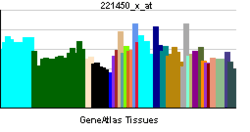PCDHB16
Protocadherin beta-16 is a protein that in humans is encoded by the PCDHB16 gene.[3][4][5]
This gene is a member of the protocadherin beta gene cluster, one of three related gene clusters tandemly linked on chromosome five. The gene clusters demonstrate an unusual genomic organization similar to that of B-cell and T-cell receptor gene clusters. The beta cluster contains 16 genes and 3 pseudogenes, each encoding 6 extracellular cadherin domains and a cytoplasmic tail that deviates from others in the cadherin superfamily. The extracellular domains interact in a homophilic manner to specify differential cell-cell connections. Unlike the alpha and gamma clusters, the transcripts from these genes are made up of only one large exon, not sharing common 3' exons as expected. These neural cadherin-like cell adhesion proteins are integral plasma membrane proteins. Their specific functions are unknown but they most likely play a critical role in the establishment and function of specific cell-cell neural connections.[5]
References
- ↑ "Human PubMed Reference:".
- ↑ "Mouse PubMed Reference:".
- ↑ Wu Q, Zhang T, Cheng JF, Kim Y, Grimwood J, Schmutz J, Dickson M, Noonan JP, Zhang MQ, Myers RM, Maniatis T (Mar 2001). "Comparative DNA Sequence Analysis of Mouse and Human Protocadherin Gene Clusters". Genome Res. 11 (3): 389–404. doi:10.1101/gr.167301. PMC 311048
 . PMID 11230163.
. PMID 11230163. - ↑ Vanhalst K, Kools P, Vanden Eynde E, van Roy F (Apr 2001). "The human and murine protocadherin-beta one-exon gene families show high evolutionary conservation, despite the difference in gene number". FEBS Lett. 495 (1–2): 120–5. doi:10.1016/S0014-5793(01)02372-9. PMID 11322959.
- 1 2 "Entrez Gene: PCDHB16 protocadherin beta 16".
Further reading
- Yagi T, Takeichi M (2000). "Cadherin superfamily genes: functions, genomic organization, and neurologic diversity". Genes Dev. 14 (10): 1169–80. doi:10.1101/gad.14.10.1169. PMID 10817752.
- Nollet F, Kools P, van Roy F (2000). "Phylogenetic analysis of the cadherin superfamily allows identification of six major subfamilies besides several solitary members". J. Mol. Biol. 299 (3): 551–72. doi:10.1006/jmbi.2000.3777. PMID 10835267.
- Frank M, Kemler R (2003). "Protocadherins". Curr. Opin. Cell Biol. 14 (5): 557–62. doi:10.1016/S0955-0674(02)00365-4. PMID 12231349.
- Matsuyoshi N, Tanaka T, Toda K, Imamura S (1997). "Identification of novel cadherins expressed in human melanoma cells". J. Invest. Dermatol. 108 (6): 908–13. doi:10.1111/1523-1747.ep12292703. PMID 9182820.
- Wu Q, Maniatis T (1999). "A striking organization of a large family of human neural cadherin-like cell adhesion genes". Cell. 97 (6): 779–90. doi:10.1016/S0092-8674(00)80789-8. PMID 10380929.
- Wu Q, Maniatis T (2000). "Large exons encoding multiple ectodomains are a characteristic feature of protocadherin genes". Proc. Natl. Acad. Sci. U.S.A. 97 (7): 3124–9. doi:10.1073/pnas.060027397. PMC 16203
 . PMID 10716726.
. PMID 10716726.
- Nagase T, Kikuno R, Nakayama M, et al. (2001). "Prediction of the coding sequences of unidentified human genes. XVIII. The complete sequences of 100 new cDNA clones from brain which code for large proteins in vitro". DNA Res. 7 (4): 273–81. doi:10.1093/dnares/7.4.271. PMID 10997877.
- Strausberg RL, Feingold EA, Grouse LH, et al. (2003). "Generation and initial analysis of more than 15,000 full-length human and mouse cDNA sequences". Proc. Natl. Acad. Sci. U.S.A. 99 (26): 16899–903. doi:10.1073/pnas.242603899. PMC 139241
 . PMID 12477932.
. PMID 12477932.
- Gevaert K, Goethals M, Martens L, et al. (2004). "Exploring proteomes and analyzing protein processing by mass spectrometric identification of sorted N-terminal peptides". Nat. Biotechnol. 21 (5): 566–9. doi:10.1038/nbt810. PMID 12665801.
- Gerhard DS, Wagner L, Feingold EA, et al. (2004). "The Status, Quality, and Expansion of the NIH Full-Length cDNA Project: The Mammalian Gene Collection (MGC)". Genome Res. 14 (10B): 2121–7. doi:10.1101/gr.2596504. PMC 528928
 . PMID 15489334.
. PMID 15489334.

 . PMID 11230163.
. PMID 11230163. . PMID 10716726.
. PMID 10716726. . PMID 12477932.
. PMID 12477932. . PMID 15489334.
. PMID 15489334.